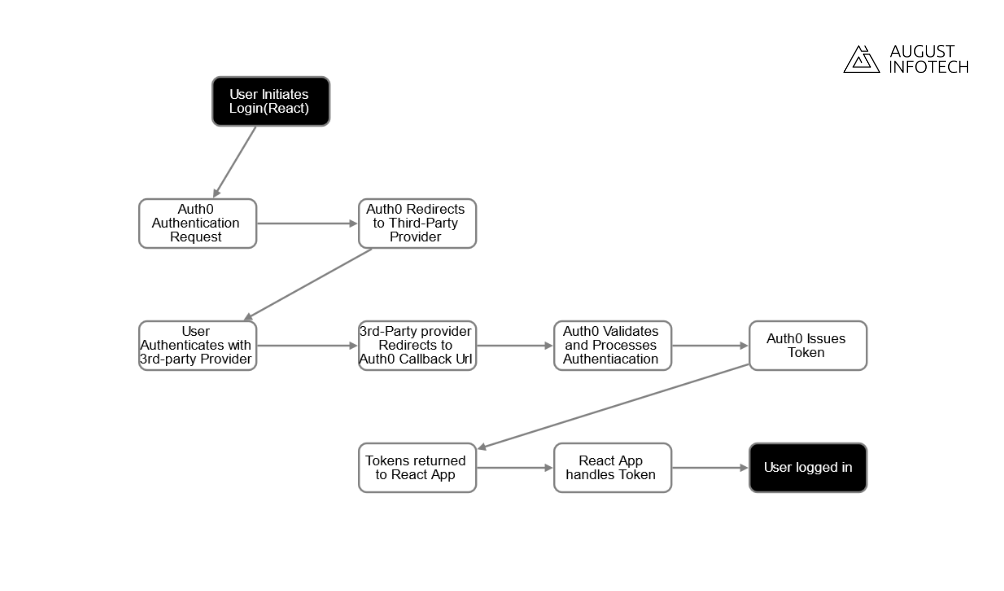Introduction:
Many web applications have a fundamental aspect of User Authentication using third-party login. This functionality provides the better experience to the user. Through this blog post, we’ll explore how to implement third-party login in a React application using Auth0 focusing on the Auth0 security features.
For this we will be using Auth0 React SDK. This is a JavaScript library for implementing authentication and authorization in React apps with Auth0. It provides a custom React hook and other Higher Order Components so you can secure React apps using best practices while writing less code, leveraging Auth0 security features. This approach contributes to react app experience improvement by streamlining the authentication process.
Understanding third-party login:
To allows the users to sign in to a website or application using their existing credentials from external identity providers such as Microsoft, Google, Facebook, and more, the third-party-login is used. This approach offers several advantages, which are as follows:
Streamlined user onboarding:
- Users can sign up or log in with just a few clicks, eliminating the need to create and remember yet another set of credentials.
- Faster and more straightforward registration process increases user conversion rates.
Enhanced user experience:
- Users appreciate the convenience of using familiar login credentials from trusted identity providers.
- Access to user data from third-party platforms can be leveraged to personalize the user experience.
Increased security:
- Auth0 employs industry-standard security practices, ensuring that user data remains secure during authentication.
- Multi-factor authentication and other security features further enhance the overall security posture.
Setting up your react application:
Before diving into third-party login, ensure you have a React application set up. You can create one using tools like Create React App:
npx create-react-app my-auth0-react-app
cd my-auth0-react-app
Integrating auth0 into your react application:
Create an auth0 account:
-
Create an Auth0 account by signing up
-
Then, create a new application in the Auth0 dashboard to obtain your client ID and client secret.
Install auth0 react sdk:
Install the Auth0 React SDK in your React application.
npm install @auth0/auth0-react
Configure auth0provider:
Wrap your React application with the Auth0Provider in the index.js file, providing the necessary configuration. Here we are integrating Auth0 into React.
// src/index.js
import { Auth0Provider } from '@auth0/auth0-react';
ReactDOM.render(
<Auth0Provider
domain="your-auth0-domain"
clientId="your-client-id"
redirectUri={window.location.origin}
>
<App />
</Auth0Provider>,
document.getElementById('root')
);
Implementing third-party login:
Auth0 makes it easier for us to integrate the third-party login into your application through its overall set of features. Here’s a step-by-step guide to implementing third-party login with Auth0:
Create an auth0 account:
For an Auth0 account. you need to Sign up and set up a new application to obtain your client ID and client secret.
Configure social connections configuration:
In the Auth0 dashboard, configure the social connections you want to enable (e.g., Microsoft, Google).
-
Integrate Auth0 SDK:
Use the Auth0 SDK into your application, allowing seamless communication with the Auth0 platform.
Implement llogin flow:
Use the Auth0 SDK to implement the third-party login flow, redirecting users to the selected identity provider for authentication.
Handle callbacks:
Implement callback functionality to handle the response from the identity provider and complete the authentication process.
Customize user profiles:
Leverage Auth0 Rules to customize user profiles and manage user data obtained from third-party providers.
Implementing third-party login in react application:
Now that Auth0 is integrated, let’s implement third-party login in your React components.
Create a login component:
Create a new component for handling the login functionality. You can use the useAuth0 hook provided by Auth0.
// src/components/LoginButton.js
import { useAuth0 } from '@auth0/auth0-react';
const LoginButton = () => {
const { loginWithRedirect } = useAuth0();
return <button onClick={() => loginWithRedirect()}>Log In</button>;
};
export default LoginButton;
Secure routes:
If you have specific routes that require authentication, wrap them with the ProtectedRoute component provided by Auth0.
// src/components/ProtectedRoute.js
import { useAuth0 } from '@auth0/auth0-react';
import { Route } from 'react-router-dom';
const ProtectedRoute = ({ children, ...rest }) => {
const { isAuthenticated } = useAuth0();
return (
<Route
{...rest}
render={() => (isAuthenticated ? children : <div>Unauthorized</div>)}
/>
);
};
export default ProtectedRoute;
Logout component:
Implement a component for logging out using the logout function from useAuth0.
// src/components/LogoutButton.js
import { useAuth0 } from '@auth0/auth0-react';
const LogoutButton = () => {
const { logout } = useAuth0();
return <button onClick={() => logout()}>Log Out</button>;
};
export default LogoutButton;
Flow diagram of the above process is as follows:

Common mistakes and best practices:
-
Avoid hardcoding credentials. Use environment variables instead.
-
Regularly update your Auth0 SDK to leverage the latest AuthO security features.
Conclusion:
Integrating third-party login in React apps with Auth0 is not just about adding a feature; it’s about enhancing the user journey. With the ease provided by Auth0’s hooks and components, you’re not just building an application; you’re crafting an experience. Whether it’s the familiarity of Google or the reach of Facebook, Auth0 ensures your authentication process is a breeze.
Remember, the world of web development best practices is ever-evolving. Stay curious, stay updated, and never stop learning.
Written by: Divya John, Senior Full Stack Developer at August Infotech an offshore development company.
About the author:
Divya John’s journey in the tech world is a testament to growth and versatility. Starting her career as a WordPress developer at August Infotech, she quickly expanded her horizons and skill set. Her passion for learning and adaptability led her to become a proficient full stack developer, adept at handling complex projects spanning multiple technologies. Recently, Divya has been channeling her expertise into the realm of data science in web development, working on innovative projects that sit at the intersection of development and data analytics. Her journey reflects a dedication to mastering new challenges and a commitment to technological excellence.
About August Infotech – Focusing on data science:
At August Infotech, data science isn’t just a service; it’s a cornerstone of our innovation strategy. We specialize in turning data into actionable insights and powerful solutions. Our team, equipped with expertise in the latest data science technologies and methodologies, focuses on delivering bespoke solutions that enable businesses to harness the full potential of their data. From predictive analytics in business to machine learning models, we transform raw data into strategic assets, driving growth and efficiency. In an era where data is king, August Infotech stands as a key ally for businesses looking to leverage data science for informed decision-making and competitive advantage. Our dedicated team works closely with clients to tailor solutions that fit their unique needs, part of our commitment to leveraging data for growth and efficiency.
Our innovation strategy with data science focuses on applying cutting-edge techniques to solve real-world problems, underscoring our belief in August Infotech data science services as a driver of business transformation and success.






